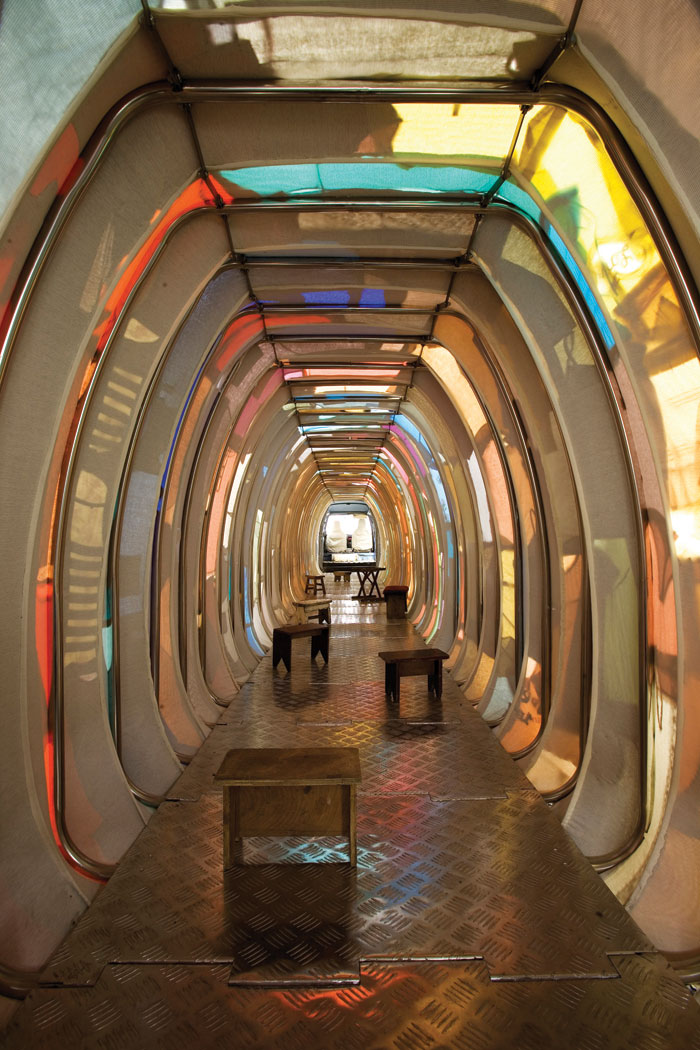“I like clothing as a material. For me it is not simply cloth, but a ‘second skin’ that carries many other things, like personal memory and different historical epochs and social backgrounds.
-Yin Xiuzhen
Arguably one of the best-known Chinese artists today, artist Yin Xiuzhen, has been exploring personal experiences of social transformation in her installation works from a subtle, female perspective. Contrasting personal clothes, handmade crafts, and daily objects with industrial products Yin visualizes, in an appealing and intimate way, the intertwined relationship between urban modernization and memory, society and the individual, gender and body.
As a local who was born and grew up in Beijing, Yin began her professional artist career after graduating from Capital Normal University of Beijing in 1989. Inspired by new ways of artistic expressions, Yin, bored of traditional media, became interested in making three-dimensional and outdoor works. She married another artist colleague, Song Dong, in 1992 and continued to live and work in Beijing. The couple’s home, a small traditional courtyard house (siheyuan), was demolished alongside many other siheyuan houses during the massive urban reconstruction of Beijing in 1998. The artist’s personal feelings towards the rapid urban transformation of her hometown and the sudden emergence of new ruins in central Beijing culminated in the installation piece Ruined City (1996), which was displayed at the art museum of the Capital Normal University of Beijing.
In Ruined City, which occupies the 300-square-meter exhibition space, Yin reconstructs a ruined siheyuan house by using fragments of roof tiles and pieces of abandoned furniture, all collected from demolished sites. She poured tons of dry cement dust all over the place, piling it on the top of the bed, chairs, closet, desk, dresser, and water washstand. Roof tiles were laid out in a diagonal path across the entire space. The installation, which looks like an interior of an old, collapsed house buried under cement dust, is a metaphor for the disappearance of old Beijing under rapid urban modernization. The constellation of fragmented pieces of roof tiles and furniture in the debris expresses a sense of nostalgia that has haunted many Beijing citizens who have shared the intense moment of witnessing history erased.
Cement has been one of Yin’s most powerful visual languages and her juxtaposition of cement with clothes and personal objects has become a recurring theme in her works of the 1990s, such as Suitcase (1995), Dining Table (1998), Scenery (1999), and A Thousand Shoes (1999). For example, in Suitcase, Yin laid out her own clothes on the ground, folded them into a suitcase, and then sealed the clothes with cement. In Dining Table, she embedds fresh fruit into a cement table, which was left with dots when the fruit eroded gradually. Yin’s longstanding obsession with handmade crafts and clothes can be traced back to her childhood hobby of sewing. The contrast of extremely opposite textures—hard, industrial, and permanent cement versus soft, personal and perishable cloths or fruit—have led critics to interpret her work as an allegorical comment on the relationship between an immobile industrial society and a suppressed, fragile individuality. The artist’s performance of sealing clothes and fruit into the cement therefore represented her attempts to “coagulate” her personal past, a futile attempt that failed alongside the decomposition of objects.
The dotted holes in the cement table, left by the decomposition of fruit or clothes, parallels the dust-covered furniture and roof tiles in Ruined City, as both were traces of a process of disappearing and fragmentation of the past in the present. However, the dry cement dust in Ruined City uncovers new meaning. In an interview, the artist recalled the pervasive existence of cement dust when working in a factory. The soft and refined cement dust was not merely a symbol of industrial power but also, personal to the artist. It became a tangible form of her private memories as well as an intersection of past and present.
Having participated in various international exhibitions in the recent decade, Yin has become increasingly interested in expressing personal experiences in the context of globalization. Inspired by international travel, Portable Cities (2001-present) is an on-going series of opened suitcases, on each of which the artist has made a cluster of landmark architecture out of old clothes. The number of suitcases increases as the artist visits more new cities. The personalized souvenir-like suitcases not only represent the artist’s experiences of living in transit, they also give each city a distinctive character against the monotonous uniformity of globalization.
In addition to shifting to the global context, Yin’s recent work also grows in scale. She has wrapped entire airplane fuselages with cloth in International Flight (2006), and in the installation Collective Subconscious (2007), exhibited at the Museum of Modern Art in 2010, Yin wrapped a long tube structure with four hundred different pieces of clothing and inserted it into a bisected blue minivan to form a 38-foot-long sculpture. Visitors could enter the vehicle and sit on the small benches inside the colorful tube, while listening to an old-fashioned Chinese pop song from a speaker. Clothes collected from different people transformed the minivan into a public space of personal memories. The cozy atmosphere in warm-toned lights recalled a time tunnel of the recent past in Chinese urban progression, when the minivan was the symbol of a Chinese car dream. In this piece, as well as in her other works, Yin expresses her keen sensitivity to personal stories in everyday life, characterizing a unique living experience in contemporary Chinese society, namely, a changing present infused with a fragmented, haunting past.
By. Yu Yang
























